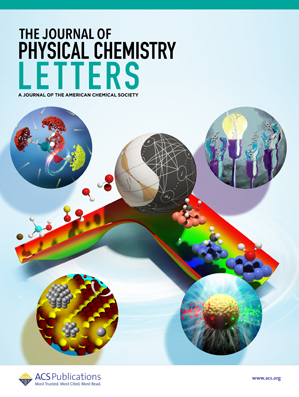Toward Generalized Solution-State 1H DNP NMR via Particle-Mediated Cross-Relaxation.
IF 4.8
2区 化学
Q2 CHEMISTRY, PHYSICAL
引用次数: 0
Abstract
This study discusses a potential route for enhancing 1H NMR signals in the liquid phase at high magnetic fields for samples on the 100 μL volume scale using dynamic nuclear polarization (DNP). The approach involves dispersing an inert powder that is both rich in protons and capable of undergoing DNP with good efficiency at noncryogenic temperatures, and letting the solid 1H polarization thus enhanced pass from the dispersed particles onto the surrounding liquid via spontaneous cross relaxation effects. To this end, BDPA-doped polystyrene (PS) particles in the μm range were suspended in 30 μL of heptane, loaded into 3.2 mm sapphire rotors, and spun at ≈500 Hz for homogeneity purposes in a 14.1 T magnet. Irradiation with ≈13 W at 395 GHz while maintaining temperature in the 185-220 K range thus enhanced the PS proton polarization ≈12-fold within ≈2 s; after ca. 6 s of irradiation, this resulted in ca. 3-fold enhancements of the heptane proton resonances, while preserving their ≤2 Hz line widths. The conditions over which such particle-mediated transfer occurs were explored over a range of sample composition, deuteration and molecular weight; best results were obtained when polarizing a ball-milled powder made of deuterated-PS/PS/BDPA = 86.4/9.6/4.0 suspended on perdeuterated heptane-d16. While the solution-state enhancements provided by this approach are still relatively modest, its generality could open new avenues in DNP-enhanced 1H NMR that do not sacrifice on the volumes, on the high-resolution conditions, or on the multiscan averaging that is customary in contemporary applications.用粒子介导的交叉弛豫研究广义溶液态1H DNP核磁共振。
本研究探讨了一种利用动态核极化(DNP)增强100 μL体积尺度样品在高磁场下液相1H NMR信号的可能途径。该方法包括分散一种既富含质子又能在非低温下高效进行DNP的惰性粉末,并通过自发交叉弛豫效应让分散的颗粒中的固体1H极化通过自发交叉弛豫效应传递到周围的液体中。为此,在30 μL的庚烷中悬浮掺bdpa的μm范围内的聚苯乙烯(PS)颗粒,将其装入3.2 mm的蓝宝石转子中,并在14.1 T磁铁中以≈500 Hz的频率旋转以达到均匀性目的。在185 ~ 220 K温度范围内,395 GHz下以≈13 W辐照,PS质子极化率在约2 s内提高了约12倍;经过约6 s的辐照后,这导致了约3倍的庚烷质子共振增强,同时保持其≤2 Hz的线宽。这种粒子介导的转移发生的条件在样品组成、氘度和分子量的范围内进行了探索;以氘化-PS/PS/BDPA = 86.4/9.6/4.0的球磨粉悬浮在过氘化庚烷-d16上,极化效果最好。虽然这种方法提供的溶液状态增强仍然相对适度,但它的通用性可以为dnp增强的1H NMR开辟新的途径,这些途径不会牺牲当前应用中习惯的体积、高分辨率条件或多扫描平均。
本文章由计算机程序翻译,如有差异,请以英文原文为准。
求助全文
约1分钟内获得全文
求助全文
来源期刊

The Journal of Physical Chemistry Letters
CHEMISTRY, PHYSICAL-NANOSCIENCE & NANOTECHNOLOGY
CiteScore
9.60
自引率
7.00%
发文量
1519
审稿时长
1.6 months
期刊介绍:
The Journal of Physical Chemistry (JPC) Letters is devoted to reporting new and original experimental and theoretical basic research of interest to physical chemists, biophysical chemists, chemical physicists, physicists, material scientists, and engineers. An important criterion for acceptance is that the paper reports a significant scientific advance and/or physical insight such that rapid publication is essential. Two issues of JPC Letters are published each month.
 求助内容:
求助内容: 应助结果提醒方式:
应助结果提醒方式:


